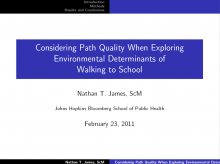We are pleased to announce an exciting new alliance between Active Living Research and GP RED to co-host and coordinate...
Considering Path Quality When Exploring Environmental Determinants of Walking to School

Presentation at the 2011 Active Living Research Annual Conference
Background:
Active transport to school has been an increasingly popular subject of research driven largely by efforts to promote physical activity as a strategy to address the childhood obesity epidemic. The physical and social environments are important determinants of a child’s likelihood of walking to school. Prior studies have most often measured the environment by using self-reported perceptions, objectively collected audits, or archival Geographic Information Systems (GIS) databases. Few studies have quantified the quality of the path, in addition to or in replacement of the more commonly utilized path length (distance to school), that children would walk to and from school as a potential determinant.
Objectives:
To develop a methodology which uses an objective street block level audit, spatial statistics, and GIS to create a measure of walking path quality based on physical and social disorder. The path quality metric is demonstrated in a regression analysis of walking to school status for a sample of children in Baltimore City, Maryland.
Methods:
Data from two main sources, the Neighborhood Inventory for Environmental Typology (NIfETy) and The Multiple Opportunities to Reach Excellence (MORE) study were utilized. The NIfETy is a survey instrument developed and applied to street blocks in Baltimore City to explore environmental determinants of violence, alcohol, and other drugs (VAOD). Results from the NifETy study provided values on incivility, a measure of physical and social disorder, at 1,173 unique Baltimore City street blocks. The MORE study is a epidemiological study designed to assess the effects of long-term exposure to violence on children in Baltimore City. Data from the MORE study contained information on 362 participating children from 6 Baltimore City schools from August-October 2007, of which 56% reported walking to school all or most of the time. To develop the path quality metric, the shortest street path to school was first calculated for each of the 362 participating MORE children using ArcGIS software.
This path was used as the walking to school path. The spatial statistical method kriging was then applied to the 1,173 street level incivilities from the NifETy study to optimally predict incivility at all street segments contained in each child’s walking to school path. The predicted incivilities were summed and normalized for each child’s path yielding the path incivility score used as a measure of path quality. The path quality metric in addition to the more commonly used path length (distance to school) were regressed on the binary walking to school status for participating children from the MORE study. Interest focused on the effect of path quality as an alternative or possible synergistic effect to path length. Final regression models considered additional individual and neighborhood covariates.
Results:
Variogram analysis showed the 1,173 NifETy incivility scores to be highly spatially correlated. An ordinary kriging model was deemed appropriate and used to optimally predict incivility along each child’s walking to school path. Akaike’s Information Criterion and kriged prediction variances were used to evaluate the kriging analysis. Ordinary kriged incivilities were summed and normalized to each path’s total distance for each child. The average length of the shortest path to school was 3702 feet, or about 0.7 miles. The mean path quality per 100 ft was 4.8 indicating that children who walked along the shortest path from home to school would encounter, on average, a little less than 5 features indicating physical and social disorder for every 100 feet walked. Both path quality and distance had statistically significant associations with the odds of walking to school in univariate logistic regression analyses. However, in multivariable models including a range of other factors and adjusting for neighborhood level clustering, path quality was not significantly associated with odds of walking to school.
Conclusions:
Path quality is an important neighborhood factor to consider among the myriad factors associated with walking to school. The methodology developed here addresses a gap in the literature by combining an objective audit instrument with spatial statistics and GIS to produce a measure which is reproducible, can be tailored to focus on specific environmental domains, and is easily calculated for every block in the study region. Its use is not dependent on a specific audit instrument and can be modified based on the study context and available data. Although average path quality was not significantly associated with odds of walking to school in the multivariate model, the methodology provides a framework for predicting objectively based values at unsampled locations and incorporating detailed measures of walking environment into physical activity studies. Future research will focus on better prediction of objective audit values and development of improved measures of individual walking environment.
Support:
This research was supported by funding from the Active Living Research Program.
Related Tools & Resources
STAY UP TO DATE
RECENTLY ADDED TOOLS & RESOURCES
MOVE! A BLOG ABOUT ACTIVE LIVING
The "Active Living Conference" aims to break down research and practice silos and...







